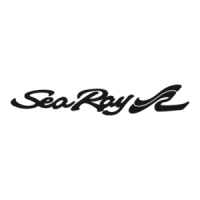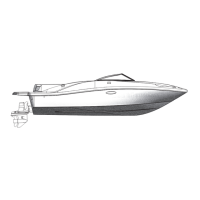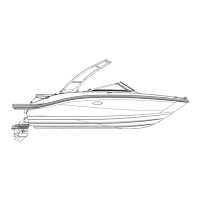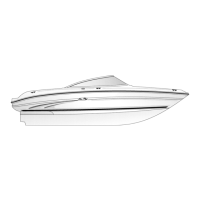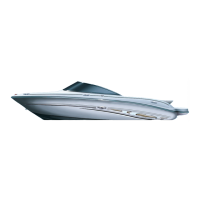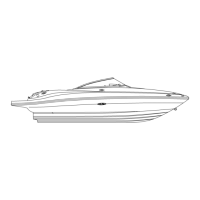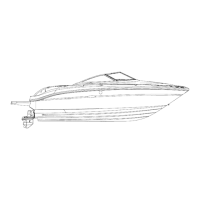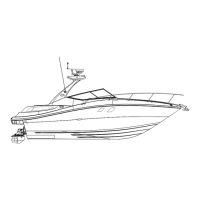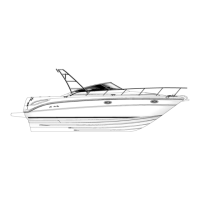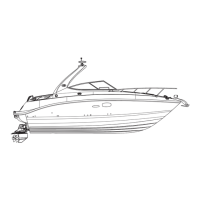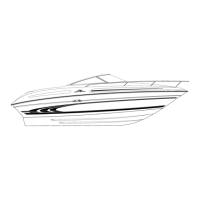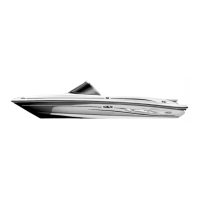
Do you have a question about the Sea Ray 180 Sport and is the answer not in the manual?
| Max Horsepower | 190 hp |
|---|---|
| Dry Weight | 2, 100 lbs (952 kg) |
| Fuel Capacity | 21 gal (79.5 L) |
| Seating Capacity | 8 people |
| Length Overall | 18 ft / 5.49 m |
| Draft | 34 in / 0.86 m |
Outlines the content and purpose of the owner's manual.
Details owner's responsibilities for safe boating and knowledge.
Lists resources for boating courses and further information.
Outlines the dealer's responsibilities regarding the boat delivery.
Explains the warranty coverage and where to find details.
Explains the importance and location of the Hull Identification Number.
Details Sea Ray's compliance with safety standards and certifications.
Provides contact information for service, parts, and repair.
Lists contact phone numbers and internet addresses for various services.
Explains the meaning and importance of various safety labels on the boat.
Lists essential safety equipment required by law for the boat.
Details the required fire extinguishers and their proper use.
Warns about carbon monoxide hazards and prevention measures.
Covers the requirements and types of personal flotation devices (PFDs).
Lists recommended safety equipment beyond legal requirements.
Warns against operating the boat under the influence of drugs or alcohol.
Explains how to determine and adhere to the boat's load capacity.
Advises on adhering to the maximum engine power rating.
Discusses factors affecting boat stability and distribution of weight.
Emphasizes the importance of operator awareness and control.
Guides on understanding weather conditions and their impact on boating.
Stresses the importance of planning routes and knowing hazards.
Provides safety guidelines for swimming and water skiing.
Outlines procedures for medical emergencies and water rescue.
Lists safety hotlines for obtaining information and assistance.
Mentions construction standards and regulatory authorities.
Defines common nautical terms for understanding.
Explains various symbols used in controls and diagrams.
Covers responsible practices for fuel/oil discharge and waste disposal.
Shows locations of various warning and safety labels on the boat.
Explains safe practices for docking, lifting, and trailering the boat.
Details safe seating and movement areas for passengers.
Describes the boat's stern drive propulsion system.
Information on propeller selection and its impact on engine performance.
Provides key dimensions and clearance specifications for the boat.
Illustrates the layout of standard deck features and components.
Identifies and explains the gauges and switches at the helm station.
Details the function and location of through-hull fittings.
Details the major controls for operating the boat's systems.
Explains the operation of the gear shift and throttle control lever.
Describes the function of the power trim system and its gauge.
Explains the function of the trailer switch for the drive unit.
Details the function and importance of key boat gauges.
Explains the tachometer and hour meter functions and importance.
Describes the function of vital engine and fuel gauges.
Details the use and importance of navigation and anchor lights.
Provides a comprehensive checklist for pre-use, launch, and post-use boat operations.
Guides on proper techniques for trailer launching and loading.
Details safe procedures for fueling the boat, including precautions.
Provides safety instructions for boarding the boat.
Reinforces the importance and proper use of PFDs for all occupants.
Advises on instructing passengers and their safe positioning.
Outlines pre-start checks and procedures for starting the engine safely.
Explains how to shift gears and maneuver the boat safely.
Details the procedure for safely stopping the boat's engine.
Explains the steering system and its maintenance requirements.
Covers bilge area, fuel/oil spillage, drain plug, and bilge pump.
Prohibits discharging fuel or oily waste into navigable waters.
Emphasizes installing the drain plug before launching to prevent sinking.
Explains the operation and maintenance of the bilge pump.
Details the assembly and operation of the bilge pump system.
Advises on minimizing stern drive damage from impacts.
Guides on selecting the correct propeller for optimal engine performance.
Provides step-by-step instructions for propeller removal and installation.
Illustrates the layout of components within the boat's bilge area.
Describes the standard gasoline fuel system components and their functions.
Explains the function of the anti-siphon valve in the fuel system.
Details essential precautions to be observed during fueling.
General precautions for fueling including safety measures.
Checklist of items to ensure before and during fueling.
Checklist of actions to take after completing fueling.
Explains the 12-volt DC electrical system and battery maintenance.
Details the DC electrical system, battery power, and maintenance.
Details the importance of ignition protection in gasoline environments.
Guides on fuse replacement and identifies fuse locations and types.
Information on navigation lights and bulb replacement.
Explains electrolytic corrosion and the role of zinc anodes.
Illustrates the layout and routing of wire harnesses on the boat.
Provides DC wiring diagrams for boats with jump seats.
Provides DC wiring diagrams for boats with sun pads.
Shows the location of major equipment and accessories on the boat.
Discusses the use, installation, and safety regarding canvas covers.
Provides tips for installing canvas supports and adjustments.
Warns against trailering with canvas attached to prevent damage.
Refers to Section 9 for canvas care and maintenance instructions.
Summarizes inspection and maintenance schedules for various boat systems.
Details inspection, service, and maintenance protocols for boat systems.
Details inspection procedures for the bilge area, including pump and float switch.
Guides on inspecting the fuel system for leaks and loose fittings.
Provides safety precautions for working on the boat's wiring system.
Details inspection of bilge fittings, hoses, clamps, and fasteners.
Covers inspection of topside equipment and critical safety supplies.
Provides a checklist for winterizing the boat before storage.
Outlines procedures for preparing the boat after storage.
Advises on securing the boat when unattended.
Details maintenance procedures for the power steering system.
Recommends products and practices for maintaining the boat's appearance.
Warns about hazardous ingredients in cleaning materials and proper usage.
Explains gelcoat properties and maintenance for colored hulls.
Provides guidance on cleaning stains and minor scratches.
Discusses preventing marine growth on boat bottoms.
Details cleaning and inspection of bottom paint.
Covers cleaning and inspection of the bilge and engine compartment.
Covers care for topside areas including fittings and instruments.
Advises on cleaning and protecting stainless steel and alloy fittings.
Explains how to clean salt crystals from instruments.
Provides simple cleaning instructions for gauge and switch panels.
Guides on cleaning acrylic surfaces without causing damage.
Details proper storage and cleaning of canvas and clear vinyl components.
Provides cleaning instructions for exterior upholstery fabric.
Refers to the material manufacturer's instructions for fabric care.
